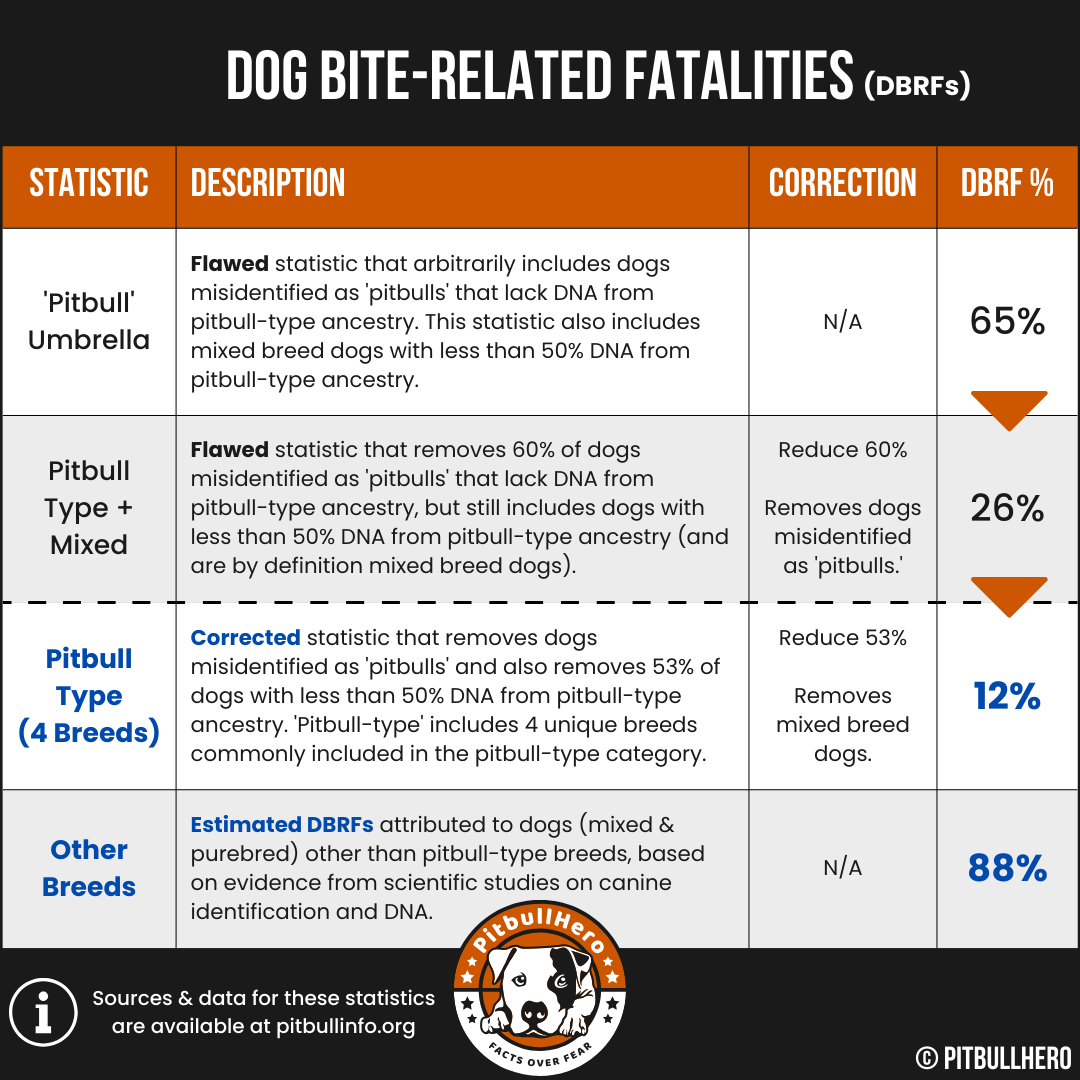Deconstructing Flawed Pitbull Statistics
Comprehensive
studies on canine DNA and visual breed identification have determined that, on average, 60% of dogs identified as 'pitbulls' lack DNA from recognized
pitbull-type breeds. This discrepancy leads to exceedingly inaccurate breed information in media reports and unreliable statistics on dog bites and attacks. Additionally, the studies show that among dogs with pitbull-type ancestry, the majority are mixed-breed dogs. Flawed statistics from unscientific organizations and special interest groups advocating for
breed-specific legislation (BSL) quickly fall apart when considering evidence from studies on canine DNA.
Flawed Pitbull Statistics ⚠️
Inaccurate statistics claiming that 'pitbulls' account for the majority (around 65%) of fatal dog attacks often result from inappropriately grouping incidents involving the four unique pitbull-type breeds, over 20 bully-type breeds (and their mixes), and various mixed breeds incorrectly identified as 'pitbulls' based on their appearance. Categorizing all of these genetically diverse dogs as 'pitbulls' naturally leads to flawed and inflated bite and fatality statistics. However, these unscientific and misleading statistics quickly fall apart when considering evidence from recent studies on canine DNA. Research shows that, on average, 60% of dogs visually identified as 'pitbulls' (by shelters, owners, and media) lack any DNA from pitbull-type ancestry. Additionally, among dogs that do have pitbull-type DNA, over half have less than 50% DNA from any pitbull-type breed, making them, by definition, mixed-breed dogs. These insights into the genetic makeup of dogs labeled as 'pitbulls' significantly affect the accuracy of dog bite statistics, medical research on dog bites, and the effectiveness of breed-specific legislation (BSL), as further explored below.

60% of Pitbulls are misidentified 📑
This study determined that, on average, 60% of dogs visually identified as 'pitbulls' are misidentified and lack DNA from pitbull-type ancestry. Misidentification is common due to the many bully-type breeds and their mixes, which are often mistaken for pitbulls. These breeds include American Bulldogs, Bullmastiffs, Cane Corsos, Dogo Argentinos, and various mixes such as Labrador-Bulldog (Bulladors) and Boxer-Bulldog, among others, which share physical traits similar to those found in pitbull-type dogs. These high misidentification rates also lead to inaccurate breed information in the media and statistics about dog bites.
65%
26%
When accounting for the fact that 60% of dogs identified as 'pitbulls' lack DNA from pitbull-type ancestry, the flawed 65% statistic is reduced by more than half to 26%.
53% of Pitbulls are Mixed-Breed Dogs 📑
Data from this study reveals that among dogs with pitbull-type DNA, more than half (53%) have less than 50% of their DNA from pitbull-type ancestry. Dogs with less than half of their DNA from a specific breed are, by definition, mixed-breed dogs, not 'pitbulls' or 'pitbull mixes.' This finding has significant implications for BSL, as cities that still enforce breed-specific legislation (BSL) typically target pitbull-type dogs with more than 50% DNA concentration from pitbull-type ancestry. Therefore, this study's results suggest that most pitbull-type dogs would not be affected by BSL if their owners challenged the legislation with DNA evidence.
26%
12%
When accounting for the fact that 53% of dogs with DNA from pitbull-type ancestry have less than half of their DNA from pitbull-type breeds, and are by definition mixed-breed dogs, the 26% statistic is further reduced by more than half to 12%.
BSL Has No Justification 🐶
Creating flawed and misleading statistics is trivial when scientific facts are not considered or are purposely ignored. These exaggerated statistics quickly fall apart when considering evidence and conclusions from comprehensive studies on canine DNA. Inaccurate statistics about pitbulls often rely on media reports, shelter/adoption information, and even social media posts as primary sources for breed identification. However, multiple studies have shown these sources to be exceedingly inaccurate and, therefore, cannot be used as reliable or valid sources for breed information. Justifying breed-specific legislation (BSL) requires accurate, breed-specific data. Yet, when scientifically valid data is used, it becomes clear that BSL has no justification. The rationale behind BSL often stems from misconceptions, stereotypes, anecdotes, and fear-based propaganda promoted by special interest groups that support BSL. Both BSL proponents and advocates for breed-neutral policies share the same goal: reducing dog bite-related incidents and improving public safety. However, only the breed-neutral approach is supported by scientific evidence, expert insights, and proven best practices for enhancing public safety and effectively reducing dog bites.
